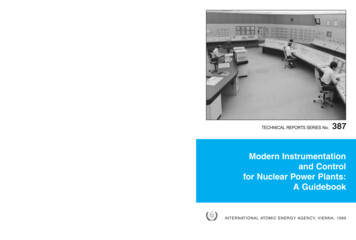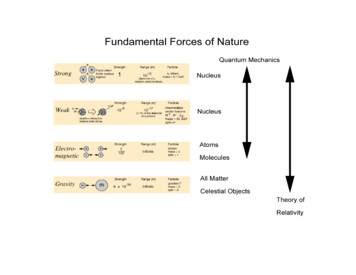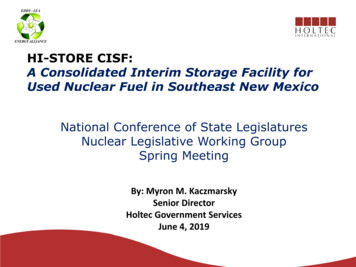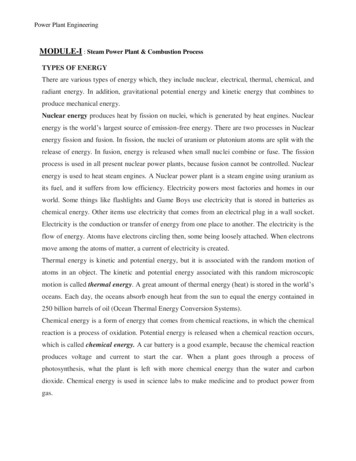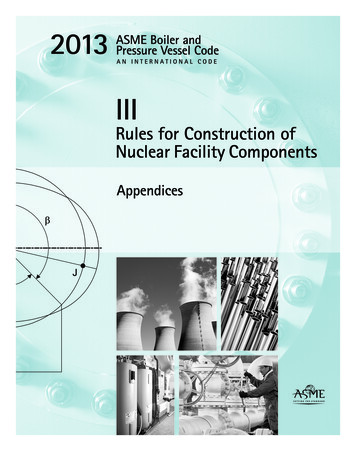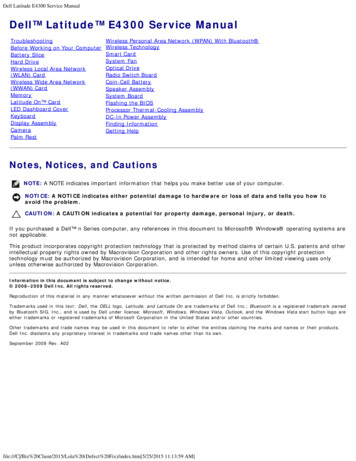
Transcription
Reactor Concepts ManualNuclear Power for Electrical GenerationNuclearPowerforElectricalGenerationThe purpose of a nuclear power plant is not to produce or release “Nuclear Power.” The purpose of anuclear power plant is to produce electricity. It should not be surprising, then, that a nuclear power planthas many similarities to other electrical generating facilities. It should also be obvious that nuclearpower plants have some significant differences from other plants.USNRC Technical Training Center1-10703
Reactor Concepts ManualNuclear Power for Electrical GenerationStationary CoilDrive ShaftRotorElectricalOutputFlangeGenerator HousingELECTRICAL GENERATOROf the several known methods to produce electricity, by far the most practical for large scale productionand distribution involves the use of an “electrical generator.” In an electrical generator, a magnet (rotor)revolves inside a coil of wire (stator), creating a flow of electrons inside the wire. This flow of electronsis called electricity. Some mechanical device (wind turbine, water turbine, steam turbine, diesel engine,etc.) must be available to provide the motive force for the rotor.USNRC Technical Training Center1-20703
Reactor Concepts ManualNuclear Power for Electrical GenerationWhen a turbine is attached to the electrical generator, the kinetic energy (i.e., motion) of the wind, fallingwater, or steam pushes against the fan-type blades of the turbine, causing the turbine, and therefore, theattached rotor of the electrical generator, to spin and produce electricity.USNRC Technical Training Center1-30703
Reactor Concepts ManualNuclear Power for Electrical GenerationH Y D RO ELECTRIC PLAN TELEC T RICALG E N E RA T O RW AT ERIN LETVALVEDAMW AT ERO U T LETW AT ERT U RB IN EIn a hydroelectric power plant, water, flowing from a higher level to a lower level, travels through themetal blades of a water turbine, causing the rotor of the electrical generator to spin and produceelectricity.USNRC Technical Training Center1-40703
Reactor Concepts ManualNuclear Power for Electrical OSSIL FUEL STEAM PLANTIn a fossil-fueled power plant, heat, from the burning of coal, oil, or natural gas, converts (boils) waterinto steam (A), which is piped to the turbine (B). In the turbine, the steam passes through the blades,which spins the electrical generator (C), resulting in a flow of electricity. After leaving the turbine, thesteam is converted (condensed) back into water in the condenser (D). The water is then pumped (E)back to the boiler (F) to be reheated and converted back into steam.USNRC Technical Training Center1-50703
Reactor Concepts ManualNuclear Power for Electrical pNuclear Fuel Steam PlantIn a nuclear power plant, many of the components are similar to those in a fossil-fueled plant, except thatthe steam boiler is replaced by a Nuclear Steam Supply System (NSSS). The NSSS consists of a nuclearreactor and all of the components necessary to produce high pressure steam, which will be used to turnthe turbine for the electrical generator.USNRC Technical Training Center1-60703
Reactor Concepts ManualNuclear Power for Electrical GenerationFissionLike a fossil-fueled plant, a nuclear power plant boils water to produce electricity. Unlike a fossil-fueledplant, the nuclear plant’s energy does not come from the combustion of fuel, but from the fissioning(splitting) of fuel atoms.USNRC Technical Training Center1-70703
Reactor Concepts ManualNuclear Power for Electrical GenerationENRICHMENT(% U-235)Uranium Ore (0.7%)Fuel Pellet (3.5%)The most common fuel for the electrical producing reactor plants in the United States is uranium. Theuranium starts out as ore, and contains a very low percentage (or low enrichment) of the desired atoms(U-235). The U-235 is a more desirable atom for fuel, because it is easier to cause the U-235 atoms tofission (split) than the much more abundant U-238 atoms. Therefore, the fuel fabrication processincludes steps to increase the number of U-235 atoms in relation to the number of U-238 atoms(enrichment process).USNRC Technical Training Center1-80703
Reactor Concepts ManualNuclear Power for Electrical GenerationCHEMICAL CONVERSION TO UF6ENRICHMENTPELLETIZINGTubing & End PlugsROD LOADINGSpacers & Tie PlatesBUNDLE ASSEMBLYBUNDLE FINAL INSPECTIONPACKAGING & SHIPPINGSITE INSPECTION & CHANNELINGOnce the fuel has been enriched, it is fabricated into ceramic pellets. The pellets are stacked into 12-footlong, slender metal tubes, generally made of a zirconium alloy. The tube is called the “fuel cladding.”When a tube is filled with the uranium pellets, it is pressurized with helium gas, and plugs are installedand welded to seal the tube. The filled rod is called a “fuel rod.” The fuel rods are bundled together into“fuel assemblies” or “fuel elements.” The completed assemblies are now ready to be shipped to the plantfor installation into the reactor vessel.USNRC Technical Training Center1-90703
Reactor Concepts ManualNuclear Power for Electrical GenerationREACTOR FUEL ASSEMBLIESBoth boiling water reactor and pressurized water reactor fuel assemblies consist of the same majorcomponents. These major components are the fuel rods, the spacer grids, and the upper and lower endfittings. The fuel assembly drawing on page 1-11 shows these major components (pressurized waterreactor fuel assembly).The fuel rods contain the ceramic fuel pellets. The fuel rods are approximately 12 feet long and containa space at the top for the collection of any gases that are produced by the fission process. These rods arearranged in a square matrix ranging from 17 x 17 for pressurized water reactors to 8 x 8 for boiling waterreactors.The spacer grids separate the individual rods with pieces of sprung metal. This provides the rigidity ofthe assemblies and allows the coolant to flow freely up through the assemblies and around the fuel rods.Some spacer grids may have flow mixing vanes that are used to promote mixing of the coolant as itflows around and though the fuel assembly.The upper and lower end fittings serve as the upper and lower structural elements of the assemblies. Thelower fitting (or bottom nozzle) will direct the coolant flow to the assembly through several small holesmachined into the fitting. There are also holes drilled in the upper fitting to allow the coolant flow toexit the fuel assembly. The upper end fitting will also have a connecting point for the refuelingequipment to attach for the moving of the fuel with a crane.For pressurized water reactor fuel, there will also be guide tubes in which the control rods travel. Theguide tubes will be welded to the spacer grids and attached to the upper and lower end fittings. Theguide tubes provide a channel for the movement of the control rods and provide for support of the rods.The upper end of the control rod will be attached to a drive shaft, which will be used to position the rodduring operations.A brief description and a picture of boiling water reactor fuel can be found in Chapter3 (pages 3-3 and3-7).USNRC Technical Training Center1-100703
Reactor Concepts ManualNuclear Power for Electrical GenerationHOLD DOW N SPRINGROD CLUSTER CONTROLTOP NOZZLEFUEL RODCONTROL RODTHIMBLE TUBEGRIDMIXING VANESBULGE JOINTSDASHPOT REGIONGRID SPRINGDIMPLETHIMB LE SCREWBOTTOM NOZZLEUSNRC Technical Training Center1-110703
Reactor Concepts ManualNuclear Power for Electrical GenerationAt the nuclear power plant, the fuel assemblies are inserted vertically into the reactor vessel (a large steeltank filled with water with a removable top). The fuel is placed in a precise grid pattern known as the“reactor core.”USNRC Technical Training Center1-120703
Reactor Concepts ManualContainment/DrywellNuclear Power for Electrical GenerationReactorVesselSteamLineTurbine BuildingThrottleValveSteam eactor CoreCondenserJet PumpTo/FromRiverRecirculationPumpPumpContainment Suppression ChamberThere are two basic types of reactor plants being used in the United States to produce electricity, theboiling water reactor (BWR) and the pressurized water reactor (PWR). The boiling water reactoroperates in essentially the same way as a fossil-fueled generating plant. Inside the reactor vessel, asteam/water mixture is produced when very pure water (reactor coolant) moves upward through the coreabsorbing heat. The major difference in the operation of a boiling water reactor as compared to othernuclear systems is the steam void formation in the core. The steam/water mixture leaves the top of thecore and enters two stages of moisture separation, where water droplets are removed before the steamis allowed to enter the steam line. The steam line, in turn, directs the steam to the main turbine, causingit to turn the turbine and the attached electrical generator. The unused steam is exhausted to thecondenser where it is condensed into water. The resulting water (condensate) is pumped out of thecondenser with a series of pumps and back to the reactor vessel. The recirculation pumps and the jetpumps allow the operator to vary coolant flow through the core and to change reactor power.Boiling water reactors are manufactured in the United States by the General Electric Company, San Jose,California. Boiling water reactors comprise about one-third of the power reactors in the United States.USNRC Technical Training Center1-130703
Reactor Concepts ManualNuclear Power for Electrical eElectricGeneratorMainCondenserCoreRCPReactor CoolantSystemFeedwaterPumpThe pressurized water reactor (PWR) differs from the boiling water reactor in that steam is produced inthe steam generator rather than in the reactor vessel. The pressurizer keeps the water that is flowingthrough the reactor vessel under very high pressure (more than 2,200 pounds per square inch) to preventit from boiling, even at operating temperatures of more than 600EF. Pressurized water reactors makeup about two-thirds of the power reactors in the United States.Pressurized water reactors were manufactured in the United States by Westinghouse Electric Corporation(Pittsburgh, Pennsylvania), Babcock and Wilcox Company (Lynchburg, Virginia), and the CombustionEngineering Company (Windsor, Connecticut).USNRC Technical Training Center1-140703
Reactor Concepts ManualNuclear Power for Electrical edwater PumpHigh Temperature Gas-Cooled Reactor (HTGR)Another type of reactor uses helium gas instead of water as its media for removing heat from the core.The only high temperature gas-cooled reactor (HTGR) in the United States was the Fort St. Vrain plantin Colorado. The plant was manufactured by General Atomic Company of La Jolla, California. Hightemperature gas-cooled reactors are widely used in other countries.USNRC Technical Training Center1-150703
Reactor Concepts ManualNuclear Power for Electrical GenerationOther(biomass fuels, wood, wind,photovoltaic, and solar)( electric(10%)Electrical Production by TypeCommercial nuclear power plants generate approximately 22% of the electricity produced in the UnitedStates. The total generation is approximately 3,800 thousand gigawatt-hours.For comparison purposes, nuclear generation accounts for the following of the total electrical productionin some other countries: 75% in France, 46% in Sweden, 43% in Ukraine, 39% in south Korea, 30%in Germany, and 30% in Japan.The electricity produced in the United States from nuclear power is equivalent to 31% of the world’stotal nuclear generated electrical power. This compares with 16% for France, 13% for Japan, 7% forGermany, 5% for Russia, and 4% for South Korea and United Kingdom.USNRC Technical Training Center1-160703
Reactor Concepts ManualNuclear Power for Electrical GenerationRegion IRegion II1342920713Region IVRegion III1118118114WestinghouseGeneral ElectricCombustion EngineeringBabcock & WilcoxThere are currently 104 licensed commercial nuclear power plants in the United States. Of the 104plants, 48 were built by Westinghouse, 35 by General Electric, 14 by Combustion Engineering, and 7by Babcock & Wilcox.The illustration above shows the breakdown of the plants, by vendor, assigned to the four NRC Regions.USNRC Technical Training Center1-170703
Reactor Concepts ManualNuclear Power for Electrical DENSERCONDENSATEPUMPCIRCULATINGWATER PUMPTo operate properly, all steam plants, whether nuclear or fossil-fueled, need a circulating water systemto remove excess heat from the steam system in order to condense the steam, and transfer that heat tothe environment. The circulating water system pumps water from the environment (river, lake, ocean)through thousands of metal tubes in the plant’s condenser. Steam exiting the plant’s turbine is veryrapidly cooled and condensed into water when it comes in contact with the much cooler tubes. Sincethe tubes provide a barrier between the steam and the environment, there is no physical contact betweenthe plant’s steam and the cooling water. Because a condenser operates at a vacuum, any tube leakagein this system will produce an “inflow” of water into the condenser rather than an “outflow” of waterto the environment.USNRC Technical Training Center1-180703
Reactor Concepts ManualNuclear Power for Electrical RDISCHARGELarge Bodyof Water(ocean, lake, etc.)INTAKECIRCULATINGWATER PUMPPower plants located on the ocean (or other large bodies of water) will often discharge their circulatingwater directly back to the ocean under strict environmental protection regulations. Water is taken fromthe ocean, pumped through the thousands of small tubes in the condenser to remove the excess heat, andis then discharged back into the ocean. The expected temperature increase from circulating water inletto outlet is about 5 to 10 degrees Fahrenheit.USNRC Technical Training Center1-190703
Reactor Concepts ManualNuclear Power for Electrical ENSERFORCED DRAFTCOOLING TOWERCIRCULATINGWATER PUMPMost nuclear power plants not located on the ocean need cooling towers to remove the excess heat fromthe circulating water system. One type of cooling tower is the forced draft cooling tower. Thecirculating water is pumped into the tower, after passing through the condenser, and allowed to splashdownward through the tower, transferring some of its heat to the air. Several large electrical fans,located at the top of the cooling tower, provide forced air circulation for more efficient cooling.USNRC Technical Training Center1-200703
Reactor Concepts ManualNuclear Power for Electrical MAINCONDENSERCIRCULATINGWATER PUMPThe taller hourglass shaped, natural convection cooling towers do not require fans to transfer the excessheat from the circulating water system into the air. Rather, the natural tendency of hot air to riseremoves the excess heat as the circulating water splashes down inside the cooling tower. These towersare typically several hundred feet tall.USNRC Technical Training Center1-210703
Reactor Concepts ManualNuclear Power for Electrical GenerationCold Dry Air3530Grams ofWater perCubicMeterof EFThe “steam” vented from the top of a cooling tower is really lukewarm water vapor. IT IS NOTRADIOACTIVE. As the warm, wet air from inside the cooling tower contacts the cooler, dryer airabove the cooling tower, the water vapor which cannot be held by the cooler air forms a visible cloud.This is because the colder the air is, the lower its ability to hold water. The released cloud of vapor willonly be visible until it is dispersed and absorbed by the air. The graph above shows air’s ability to holdwater as air temperature increases.USNRC Technical Training Center1-220703
Reactor Concepts ManualNuclear Power for Electrical GenerationPRESSURIZED WATER REACTOR PLANT LAYOUTCONTAINMENT BUILDINGREACTORCOOLANT SYSTEMMSRELECTRICGENERATORS/GPZRHPLPCOOLING TOWERMAINTURBINEMAINCONDENSERCO R ERHRHXRCPRHRPUMPMAIN FEEDPUMPAUXILIARY BUILDINGCONTAINMENTSUMPFWHTRCONDENSATEPUMPCIRC. WATERPUMPTURBINE BUILDINGThe major structures at a pressurized water reactor plant are: The containment building, which houses the reactor and its high pressure steamgenerating equipment;The turbine building, which houses the steam turbines, condensers, and the electricalgenerator; andThe auxiliary building, which houses normal and emergency support systems (such asthe residual heat removal (RHR) system, fuel handling and storage equipment,laboratories, maintenance areas, and the control room).Depending upon the plant location and environmental regulations, there may or may not be a coolingtower to remove the excess heat from the facility.USNRC Technical Training Center1-230703
Reactor Concepts ManualContainment/DrywellNuclear Power for Electrical GenerationReactorVesselSteamLineTurbine BuildingThrottleValveSteam ondenserReactor CoreJet PumpTo/FromRiverRecirculationPumpPumpContainment Suppression ChamberThe major structures at a boiling water reactor plant are: The primary containment, which includes the suppression chamber, and houses thereactor and recirculation pumps;The reactor building (secondary containment), which surrounds the primary containmentand serves many of the same functions as a pressurized water reactor’s auxiliary building;andThe turbine building.Depending upon the plant location, there may or may not be a cooling tower to remove excess heat fromthe facility.USNRC Technical Training Center1-240703
Reactor Concepts Manual Nuclear Power for Electrical Generation USNRC Technical Training Center 1-1 0703 Nuclear Power for Electrical Generation The purpose of a nuclear power plant is not to produce or release “N uclear Power.” The purpose of a nuclear power plant is to produce el
